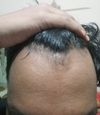community Started rosemary oil in mid Feb. quickly moved to oral min, topical min, Dut, RU, derma rolling. And keto. Top pic is March 6. Bottom is today. 40 years old.
User started with rosemary oil, then used oral minoxidil, topical minoxidil, dutasteride, RU58841, derma rolling, and keto for hair loss treatment. Significant progress was made, and others praised the aggressive approach.
